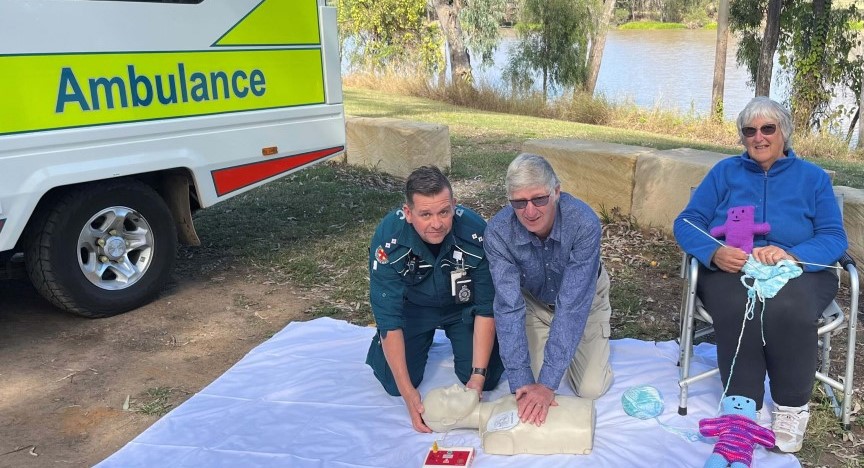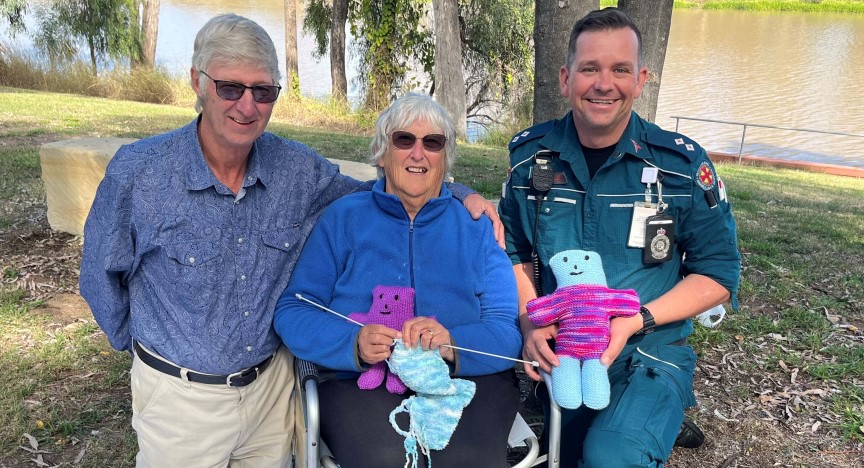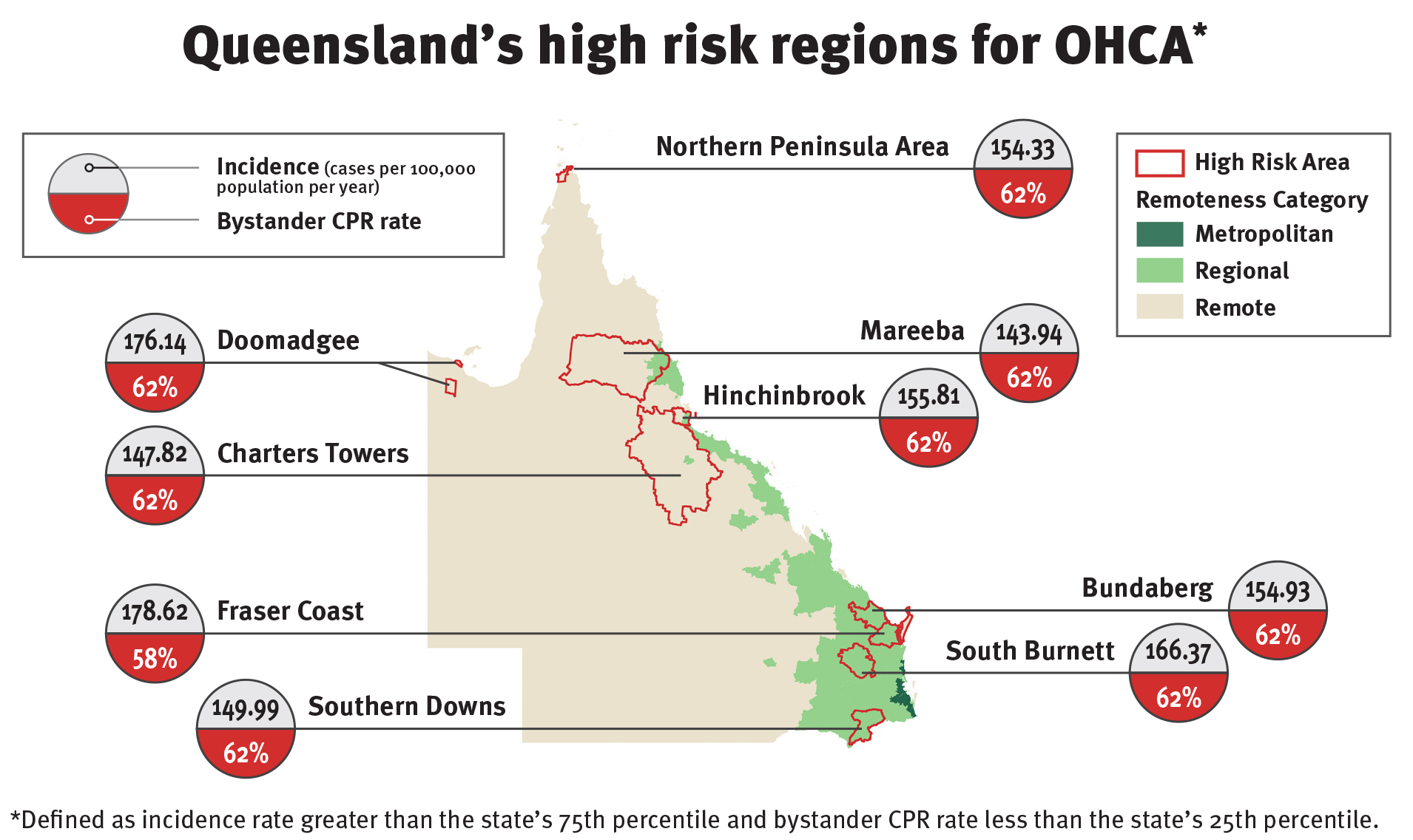
A “Grey Nomad” walks into an ambulance station…
It could be the start of a joke, but while the story the regional Victorian traveller told Baralaba’s Officer in Charge Vaughan Mason has left him with a huge and long-lasting grin, it was certainly no joke.
“I’ve been delivering CPR education sessions to the community for many years as part of our regular duties, and we often hold sessions for the folk at our camping grounds at Neville Hewitt Weir,” said Vaughan.
“These grounds are a favourite with many travellers especially the southerners, who travel north to avoid the colder, wetter months and they often end up here at the same time, so the Weir becomes an unofficial catch-up place.
“A fortnight ago [mid-July] a traveller told me he’d attended one of my CPR education sessions five years ago – before the Victorian COVID lockdowns – and what he’d learned came in handy last month when his quick actions saved a lady’s life.”
This grey nomad was Ken Coverdale, who’d travelled with his wife Ann from their hometown of Cobden, 50-km north of the famous Twelve Apostles and more than 1,900 km away from Baralaba.
Ken and Ann were at Baralaba for a few days, where they took the time to catch up with Vaughan and encouraged their friends to attend his CPR education sessions, where Ken also spoke about his life-saving experience.
Ken said from his own experience the more people who know how to do CPR and use an AED, the better.
“It would be great to see CPR being taught in all schools across the country because even primary school students can learn the basics,” Ken said.
“I did one of Vaughan’s CPR educations sessions here five years ago in a group of about 20 of us and it was a great refresher for me after my early years of being involved in the rural fire brigade.
“We practiced on mannikins to learn CPR and how to use a defibrillator.
“I could see the value in having these skills and knowledge, and so a few years ago when there was a session organised at home in Cobden, I went along to that too as a refresher.”

Ken said these sessions also served as a good reminder to know where to find community automated external defibrillators (AEDs) – another fortuitous move.
“On a Friday 23 May around 1.40pm in early June I was calling bingo to a room full of folk all well in their 70s and a lady, also called Anne, fell off her chair onto the floor,” Ken said.
“It was clear she was in trouble, and when one of her friends declared “she’s dead”, I jumped straight into action.
“I knew the AED was next door at the bowls club (we have six defibs in Cobden), so I sent someone out to grab that and got someone else to call an ambulance.
“I could soon tell Anne wasn’t breathing and her heart wasn’t beating, so I started CPR.
“I felt a crack-pop and knew I’d broken her sternum as it crackled as it gave way, but I kept going for around 15 minutes.
“When the defib arrived, its instructions were to remove clothes covering the chest area, but luckily Anne’s bra didn’t have an underwire, so we didn’t need to remove it – I just got the sticky pads on straight away.
“When the little ‘lightning bolt’ button came on, we stood back while it shocked and I then continued with the CPR for a few moments.
“At that point she took a couple of breaths and opened her eyes and said, ‘What’s happening?’.”
Ken said this all happened just as the paramedics arrived to take Anne to a waiting helicopter to get her to Geelong Hospital.
Meanwhile, the bingo players were waiting patiently, so Ken returned to the stage to continue calling the games.
“This all happened around lunch time and by 5pm our patient was in recovery after heart surgery,” he said.
Ken said the paramedics dropped by both later that afternoon and the next day to check in with him and thank him for his response, and said without his intervention, Anne wouldn’t have survived.
“I also had a thank-you call from our patient in hospital and while she said her chest was bruised and very sore, she was very happy to be alive,” Ken said.
“Anne’s specialists also said wouldn’t have survived without the immediate CPR and defibrillator.”
Vaughan said he was completely blown away by Ken’s visit and news.
“This is exactly why we do so much CPR education in our community,” he said.
“Our days out here aren’t like those in the metro areas, so we spend a lot of time teaching people of all ages – from school students right through to our grey nomads and retirees – about the importance of knowing how to provide CPR and use AEDs.
“Recognising a heart attack or cardiac arrest, starting CPR, and getting an AED into action are the vital first three steps in the chain of survival and these emergencies usually happen out in our communities.
“If it’s performed immediately, CPR can double or triple a patient’s chance of survival, and using a defib in the first minute of a sudden cardiac arrest can increase a patient’s survival rate by 90 per cent.
“Knowing the CPR education I provided here in Baralaba contributed directly to saving a person’s life in another small community nearly 2000 kms away reinforces the value of bystander CPR and people feeling confident to use AEDs – it’s just brilliant and I can’t stop smiling!”
QAS Central Region’s Director Clinical Operations Simon Edwards said the region was undergoing a cardiac arrest improvement review, looking at ways the service can improve out of hospital cardiac arrest (OHCA) patient outcomes and overall performance.
“This will not only consolidate our performance but continue to improve it for our patients and their families in our communities,” Simon said.
“As part of this, we are looking at reinvigorating our Local Ambulance Committee (LAC) membership to help us increase CPR Awareness Program delivery for all ages, particularly now its junior CPR and first aid program RESQR000s, has also been refreshed and is ready for rollout within schools and community groups.
“We will also be looking at how we can enhance the local governance of first responders and will be recruiting more local community volunteers to deliver this service, on top of the education programs through our LACs and peer trainer programs.
Earlier this year, QAS Research Fellow Dr Tan Doan identified nine high-risk regions in Queensland where residents are less likely to survive a cardiac arrest compared with residents in other parts of the state and the Bundaberg region is amongst these.
For more information about this research, click here.
